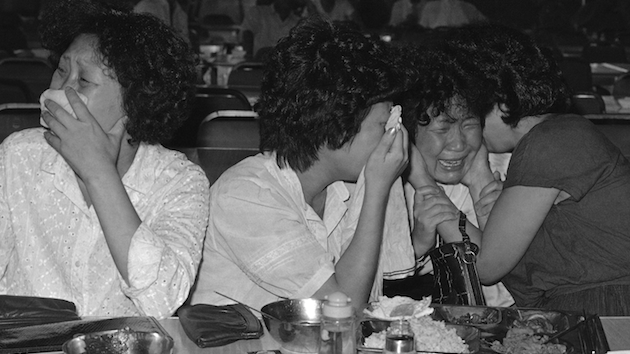by TONY KIM
Even as many people greeted the news that Malaysian Airlines Flight 17 was likely shot down by a surface-to-air missile with shock and horror, for some, the earmarks of this tragedy were sadly familiar.
While loved ones mourned the deaths of all 298 aboard the Malaysian aircraft that blew up in the sky over Ukraine—possibly a casualty of the ongoing violent conflict between Russian-backed separatists and the Ukranian government—several media outlets began recalling the painful fallout that occurred after another infamous downing of a civilian airliner 31 years earlier.
On September 1, 1983, at the height of the Cold War, a Soviet Union fighter aircraft shot down Korean Airlines Flight 007, apparently believing at that time that it was a spy plane. The 747 jet’s destruction resulted in the deaths of 269, including 105 South Koreans and 62 Americans, with the two nationalities constituting the majority of the passengers.
Newsweek, citing its own coverage of the tragedy, described the reaction at the time:
At the airport in Seoul, friends and relatives at first were told that Flight 007 was “running late.” Then airline officials reported—perhaps wishfully—that the big jet, forced down by Soviet pursuit planes, had landed safely on Sakhalin Island. When the true story finally broke, relatives went into shocked mourning and anti-Soviet demonstrations broke out from South Korea to the streets fronting the United Nations headquarters.
The incident quickly led to escalation of anti-Soviet sentiment, especially in South Korea and the United States. Then-President Ronald Reagan announced that the U.S. would continue to ban Soviet airline Aeroflot from landing in its territory and sought reparations for the victims’ families. He referred to the incident as the “Korean airline massacre” and an attack “against the world and the moral precepts which guide human relations among people everywhere,” the Wall Street Journal reported at the time. The newspaper said that Reagan used the aggression to renew his argument for why the U.S. should build up its defense program.
The Atlantic noted that this tragedy was one in a series of incidents from that period that nearly pushed the two nations to a potentially devastating nuclear war, according to declassified Cold War documents.
For many who lost their family members that day, of course, the impact was far more personal. Some are still haunted to this day because the bodies of the passengers and crew were never found. The family of Charisma LaFleur, who lost both a cousin and grandfather in the 007 flight, have even wondered over the years if there were survivors. She told the Washington Post, “The lack of that evidence is the hardest thing to deal with because not having that plagues you for the rest of your lives.”
Though it’s unclear at this point whether the investigation into the Malaysian crash will yield conclusive results as to how the incident occurred and who was responsible, it seems that there will be no similar lack of physical evidence as with Flight 007. The Washington Post reported that extensive debris can be seen in a wheat field and nearby villages in the eastern part of Ukraine:
Witnesses described looking across beautiful fields of sunflowers only to be jolted by the discovery of body parts on the ground.
Photo via AP: In this file photo from 1983, sisters of Lee Chul-Kyu, a passenger on the downed South Korean aircraft, weep, after receiving news of the crash.









